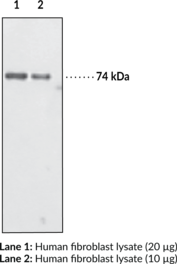Description
The dopamine transporter (DAT) is a member of the SLC6 family of transporters and is encoded by the SLC6A3 gene in humans.{55189,55190} DAT is expressed in dopaminergic neurons and localizes to perisynaptic sites, where it functions to translocate the neurotransmitter dopamine (DA; Item No. 21992) into presynaptic neurons from the extracellular space.{55191,55189} It is comprised of 12 transmembrane helices flanked by large cytoplasmic N- and C-terminal tails that are subject to protein-protein interactions with DAT binding proteins as well as posttranslational modifications.{55189,55191} DAT can be phosphorylated by ERK at threonine 53 (Thr53) in vitro.{55192} Phosphorylation of DAT at Thr53 (phospho-Thr53) is increased in rat striatal synaptosomes in response to phorbol 12-myristate 13-acetate (PMA; Item No. 10008014), okadaic acid (Item No. 10011490), amphetamine, or methamphetamine.{55192,55193} In vivo, phospho-Thr53 in rat striatum is increased following administration of methamphetamine.{55193} LLC-PK1 cells expressing rat DAT (rDAT) with non-phosphorylatable or phosphomimetic Thr53 mutations exhibit defects in DA uptake and amphetamine-induced efflux of the substrate [3H]MPP+ compared to cells expressing wild-type rDAT, indicating that phosphorylation of Thr53 has roles in regulating the uptake and efflux functions of DAT.{55192} Cayman’s Dopamine Transporter (Phospho-Thr53) Polyclonal Antibody can be used for Western blot (WB) applications. The antibody recognizes DAT (phospho-Thr53) at approximately 55 kDa from mouse and rat samples.
Synonyms: DAT|SLC6A3
Immunogen: Phosphopeptide corresponding to amino acid residues surrounding phospho-Thr53 of rat DAT
Formulation: 100 µl of affinity-purified polyclonal antibody from pooled serum
Isotype:
Applications: WB
Origin:
Stability: 365 days
Application|Western Blot||Product Type|Antibodies|Polyclonal Antibodies||Research Area|Neuroscience



